A couple of weeks ago, Alain Connes and Katia Consani arXived their paper “On the notion of geometry over $\mathbb{F}_1 $”. Their subtle definition is phrased entirely in Grothendieck‘s scheme-theoretic language of representable functors and may be somewhat hard to get through if you only had a few years of mathematics.
 I’ll try to give the essence of their definition of an affine scheme over $\mathbb{F}_1 $ (and illustrate it with an example) in a couple of posts. All you need to know is what a finite Abelian group is (if you know what a cyclic group is that’ll be enough) and what a commutative algebra is. If you already know what a functor and a natural transformation is, that would be great, but we’ll deal with all that abstract nonsense when we’ll need it.
I’ll try to give the essence of their definition of an affine scheme over $\mathbb{F}_1 $ (and illustrate it with an example) in a couple of posts. All you need to know is what a finite Abelian group is (if you know what a cyclic group is that’ll be enough) and what a commutative algebra is. If you already know what a functor and a natural transformation is, that would be great, but we’ll deal with all that abstract nonsense when we’ll need it.
So take two finite Abelian groups A and B, then a group-morphism is just a map $f~:~A \rightarrow B $ preserving the group-data. That is, f sends the unit element of A to that of B and
f sends a product of two elements in A to the product of their images in B. For example, if $A=C_n $ is a cyclic group of order n with generator g and $B=C_m $ is a cyclic group of order m with generator h, then every groupmorphism from A to B is entirely determined by the image of g let’s say that this image is $h^i $. But, as $g^n=1 $ and the conditions on a group-morphism we must have that $h^{in} = (h^i)^n = 1 $ and therefore m must divide i.n. This gives you all possible group-morphisms from A to B.
They are plenty of finite abelian groups and many group-morphisms between any pair of them and all this stuff we put into one giant sack and label it $\mathbf{abelian} $. There is another, even bigger sack, which is even simpler to describe. It is labeled $\mathbf{sets} $ and contains all sets as well as all maps between two sets.
Right! Now what might be a map $F~:~\mathbf{abelian} \rightarrow \mathbf{sets} $ between these two sacks? Well, F should map any abelian group A to a set F(A) and any group-morphism $f~:~A \rightarrow B $ to a map between the corresponding sets $F(f)~:~F(A) \rightarrow F(B) $ and do all of this nicely. That is, F should send compositions of group-morphisms to compositions of the corresponding maps, and so on. If you take a pen and a piece of paper, you’re bound to come up with the exact definition of a functor (that’s what F is called).
You want an example? Well, lets take F to be the map sending an Abelian group A to its set of elements (also called A) and which sends a groupmorphism $A \rightarrow B $ to the same map from A to B. All F does is ‘forget’ the extra group-conditions on the sets and maps. For this reason F is called the forgetful functor. We will denote this particular functor by $\underline{\mathbb{G}}_m $, merely to show off.
Luckily, there are lots of other and more interesting examples of such functors. Our first class we will call maxi-functors and they are defined using a finitely generated $\mathbb{C} $-algebra R. That is, R can be written as the quotient of a polynomial algebra
$R = \frac{\mathbb{C}[x_1,\ldots,x_d]}{(f_1,\ldots,f_e)} $
by setting all the polynomials $f_i $ to be zero. For example, take R to be the ring of Laurant polynomials
$R = \mathbb{C}[x,x^{-1}] = \frac{\mathbb{C}[x,y]}{(xy-1)} $
Other, and easier, examples of $\mathbb{C} $-algebras is the group-algebra $\mathbb{C} A $ of a finite Abelian group A. This group-algebra is a finite dimensional vectorspace with basis $e_a $, one for each element $a \in A $ with multiplication rule induced by the relations $e_a.e_b = e_{a.b} $ where on the left-hand side the multiplication . is in the group-algebra whereas on the right hand side the multiplication in the index is that of the group A. By choosing a different basis one can show that the group-algebra is really just the direct sum of copies of $\mathbb{C} $ with component-wise addition and multiplication
$\mathbb{C} A = \mathbb{C} \oplus \ldots \oplus \mathbb{C} $
with as many copies as there are elements in the group A. For example, for the cyclic group $C_n $ we have
$\mathbb{C} C_n = \frac{\mathbb{C}[x]}{(x^n-1)} = \frac{\mathbb{C}[x]}{(x-1)} \oplus \frac{\mathbb{C}[x]}{(x-\zeta)} \oplus \frac{\mathbb{C}[x]}{(x-\zeta^2)} \oplus \ldots \oplus \frac{\mathbb{C}[x]}{(x-\zeta^{n-1})} = \mathbb{C} \oplus \mathbb{C} \oplus \mathbb{C} \oplus \ldots \oplus \mathbb{C} $
The maxi-functor asociated to a $\mathbb{C} $-algebra R is the functor
$\mathbf{maxi}(R)~:~\mathbf{abelian} \rightarrow \mathbf{sets} $
which assigns to a finite Abelian group A the set of all algebra-morphism $R \rightarrow \mathbb{C} A $ from R to the group-algebra of A. But wait, you say (i hope), we also needed a functor to do something on groupmorphisms $f~:~A \rightarrow B $. Exactly, so to f we have an algebra-morphism $f’~:~\mathbb{C} A \rightarrow \mathbb{C}B $ so the functor on morphisms is defined via composition
$\mathbf{maxi}(R)(f)~:~\mathbf{maxi}(R)(A) \rightarrow \mathbf{maxi}(R)(B) \qquad \phi~:~R \rightarrow \mathbb{C} A \mapsto f’ \circ \phi~:~R \rightarrow \mathbb{C} A \rightarrow \mathbb{C} B $
So, what is the maxi-functor $\mathbf{maxi}(\mathbb{C}[x,x^{-1}] $? Well, any $\mathbb{C} $-algebra morphism $\mathbb{C}[x,x^{-1}] \rightarrow \mathbb{C} A $ is fully determined by the image of $x $ which must be a unit in $\mathbb{C} A = \mathbb{C} \oplus \ldots \oplus \mathbb{C} $. That is, all components of the image of $x $ must be non-zero complex numbers, that is
$\mathbf{maxi}(\mathbb{C}[x,x^{-1}])(A) = \mathbb{C}^* \oplus \ldots \oplus \mathbb{C}^* $
where there are as many components as there are elements in A. Thus, the sets $\mathbf{maxi}(R)(A) $ are typically huge which is the reason for the maxi-terminology.
Next, let us turn to mini-functors. They are defined similarly but this time using finitely generated $\mathbb{Z} $-algebras such as $S=\mathbb{Z}[x,x^{-1}] $ and the integral group-rings $\mathbb{Z} A $ for finite Abelian groups A. The structure of these inegral group-rings is a lot more delicate than in the complex case. Let’s consider them for the smallest cyclic groups (the ‘isos’ below are only approximations!)
$\mathbb{Z} C_2 = \frac{\mathbb{Z}[x]}{(x^2-1)} = \frac{\mathbb{Z}[x]}{(x-1)} \oplus \frac{\mathbb{Z}[x]}{(x+1)} = \mathbb{Z} \oplus \mathbb{Z} $
$\mathbb{Z} C_3 = \frac{\mathbb{Z}[x]}{(x^3-1)} = \frac{\mathbb{Z}[x]}{(x-1)} \oplus \frac{\mathbb{Z}[x]}{(x^2+x+1)} = \mathbb{Z} \oplus \mathbb{Z}[\rho] $
$\mathbb{Z} C_4 = \frac{\mathbb{Z}[x]}{(x^4-1)} = \frac{\mathbb{Z}[x]}{(x-1)} \oplus \frac{\mathbb{Z}[x]}{(x+1)} \oplus \frac{\mathbb{Z}[x]}{(x^2+1)} = \mathbb{Z} \oplus \mathbb{Z} \oplus \mathbb{Z}[i] $
For a $\mathbb{Z} $-algebra S we can define its mini-functor to be the functor
$\mathbf{mini}(S)~:~\mathbf{abelian} \rightarrow \mathbf{sets} $
which assigns to an Abelian group A the set of all $\mathbb{Z} $-algebra morphisms $S \rightarrow \mathbb{Z} A $. For example, for the algebra $\mathbb{Z}[x,x^{-1}] $ we have that
$\mathbf{mini}(\mathbb{Z} [x,x^{-1}]~(A) = (\mathbb{Z} A)^* $
the set of all invertible elements in the integral group-algebra. To study these sets one has to study the units of cyclotomic integers. From the above decompositions it is easy to verify that for the first few cyclic groups, the corresponding sets are $\pm C_2, \pm C_3 $ and $\pm C_4 $. However, in general this set doesn’t have to be finite. It is a well-known result that the group of units of an integral group-ring of a finite Abelian group is of the form
$(\mathbb{Z} A)^* = \pm A \times \mathbb{Z}^{\oplus r} $
where $r = \frac{1}{2}(o(A) + 1 + n_2 -2c) $ where $o(A) $ is the number of elements of A, $n_2 $ is the number of elements of order 2 and c is the number of cyclic subgroups of A. So, these sets can still be infinite but at least they are a lot more manageable, explaining the mini-terminology.
Now, we would love to go one step deeper and define nano-functors by the same procedure, this time using finitely generated algebras over $\mathbb{F}_1 $, the field with one element. But as we do not really know what we might mean by this, we simply define a nano-functor to be a subfunctor of a mini-functor, that is, a nano-functor N has an associated mini-functor $\mathbf{mini}(S) $ such that for all finite Abelian groups A we have that $N(A) \subset \mathbf{mini}(S)(A) $.
For example, the forgetful functor at the beginning, which we pompously denoted $\underline{\mathbb{G}}_m $ is a nano-functor as it is a subfunctor of the mini-functor $\mathbf{mini}(\mathbb{Z}[x,x^{-1}]) $.
Now we are allmost done : an affine $\mathbb{F}_1 $-scheme in the sense of Connes and Consani is a pair consisting of a nano-functor N and a maxi-functor $\mathbf{maxi}(R) $ such that two rather strong conditions are satisfied :
- there is an evaluation ‘map’ of functors $e~:~N \rightarrow \mathbf{maxi}(R) $
- this pair determines uniquely a ‘minimal’ mini-functor $\mathbf{mini}(S) $ of which N is a subfunctor
of course we still have to turn this into proper definitions but that will have to await another post. For now, suffice it to say that the pair $~(\underline{\mathbb{G}}_m,\mathbf{maxi}(\mathbb{C}[x,x^{-1}])) $ is a $\mathbb{F}_1 $-scheme with corresponding uniquely determined mini-functor $\mathbf{mini}(\mathbb{Z}[x,x^{-1}]) $, called the multiplicative group scheme.
Leave a Comment Amidst all LHC-noise,
Amidst all LHC-noise, 
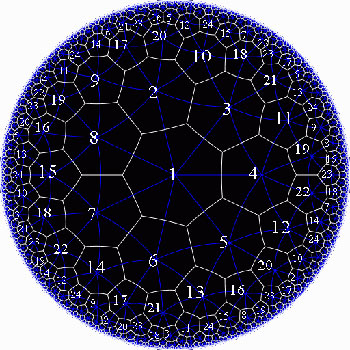
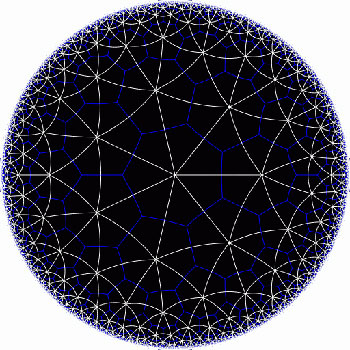
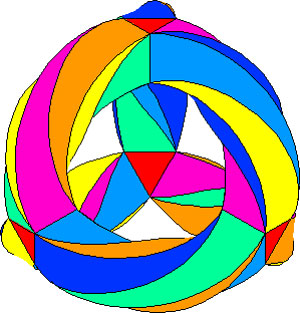
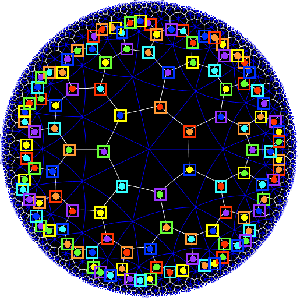
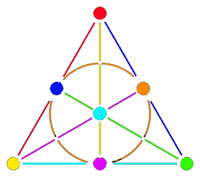 Shifting perspective, we can repeat this for each of the seven different colors. That is, we have seven truncated cubes in the Klein quartic. On each of them a copy of $S_4 $ acts and these subgroups form one of the two conjugacy classes of $S_4 $ in the group $L_2(7) $. The colors of the triangles of these seven truncated cubes are indicated by bullets in the picture above on the right. The other conjugacy class of $S_4 $’s act on ‘truncated anti-cubes’ which also come in seven bunches of which the color is indicated by a square in that picture.
Shifting perspective, we can repeat this for each of the seven different colors. That is, we have seven truncated cubes in the Klein quartic. On each of them a copy of $S_4 $ acts and these subgroups form one of the two conjugacy classes of $S_4 $ in the group $L_2(7) $. The colors of the triangles of these seven truncated cubes are indicated by bullets in the picture above on the right. The other conjugacy class of $S_4 $’s act on ‘truncated anti-cubes’ which also come in seven bunches of which the color is indicated by a square in that picture.